

| Home | For sale | Site map | Contact information | Guest book | The Panzerschreck Lounge |
 Transporting the
Panzerschreck & ammunition Transporting the
Panzerschreck & ammunition  |
|---|
The Panzerschreck during transport Hey-ho, let's go! A newsreel photo of a very well equipped anti-tank unit. Note the lack of shields, and that there are not enough ammunition boxes to go around for everyone. The standard was two boxes for each loader. The unit commander on the left edge of the picture sports two full bags Gewehrgranaten on his chest and a GGG98 on his hip (not visible from this angle) The
Panzerschreck was a heavy and
cumbersome weapon in the field, but not much worse than the average
LMG. The main method of transportation was (of course) by foot. But
even this aspect was regulated in the German manuals.
The Merkblatt 77/2 has the following instructions for the march on foot: 10. Ofenrohr and ammunition should be carried so that a) the weapon with the shooter can't be recognized from a distance b) the mobility of the shooter is restricted as little as possibly c) the crew is not subjected to any danger The D 1864/6 has the following text: 21. Carrying methods for the weapon a)
On the march: Weapon is not loaded and the trigger has not been cocked.
Carrying method free of choice or as ordered by the unit commander. For
examples see picture 15.
b) When employed as a security unit during troop movements and during combat: Weapon is loaded, the trigger has been cocked and the safety is on. Carrying method depends on the terrain. As an example see picture 16. 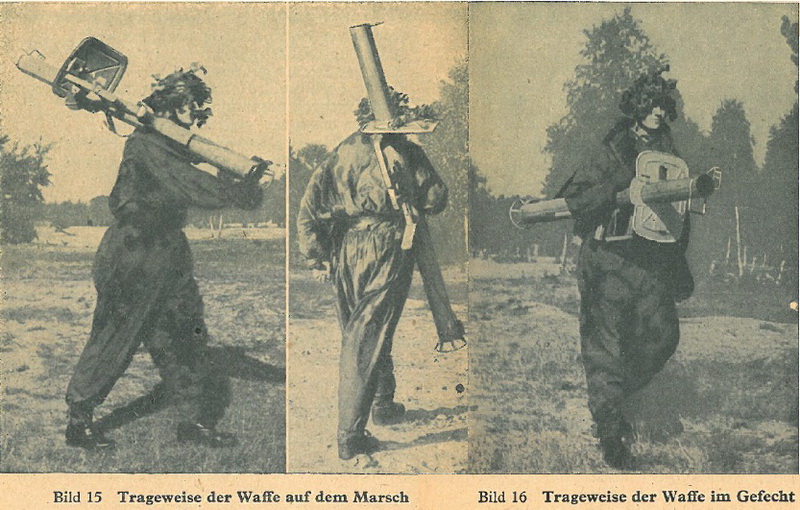 These pictures from the D 1864/6 show examples of carrying methods. The finger guard has been installed on the shield. Incredibly enough, the posing soldier is wearing a captured Russian "Ameba" pattern coverall. 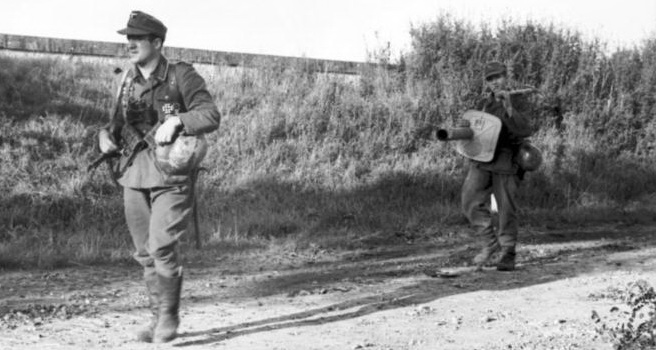 A team of Wehrmacht soldiers on the move in Northern France, summer 1944. Weapon carried in the prescribed "ready" position. When a weapon had been issued a shield, it was meant to stay attached. The manual D 1864/1 stresses that the shield should only be removed from the weapon when it is loaded on a vehicle (Abnehmen nur bei Verlastung). 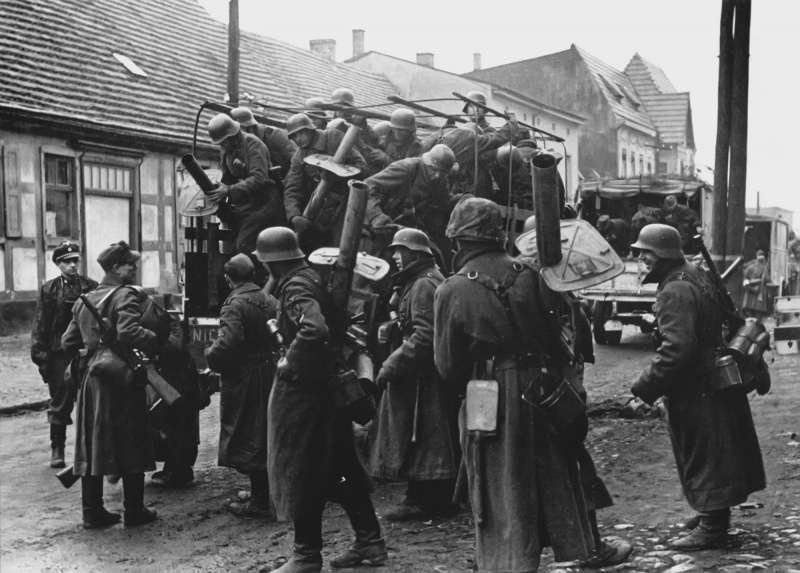 Pyritz in Pommern, 11 February 1945. The Waffen SS troops unloading from the trucks carry their Panzerschrecks with the shield in place according to regulations. 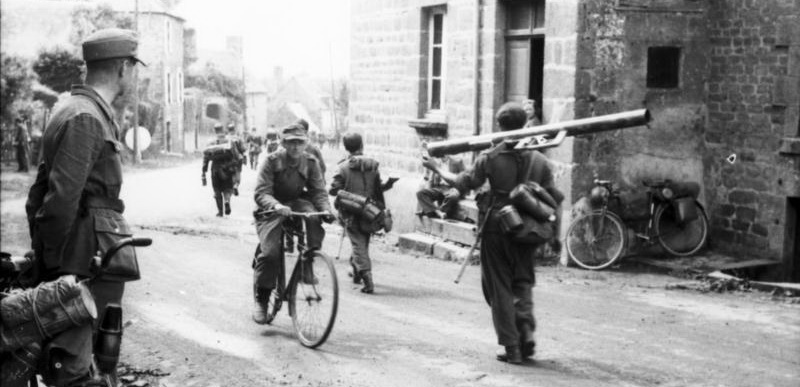 Grenadiers from the Grenadier-Regiment 1052 passing through the city of Ger in Normandy, August 1944. 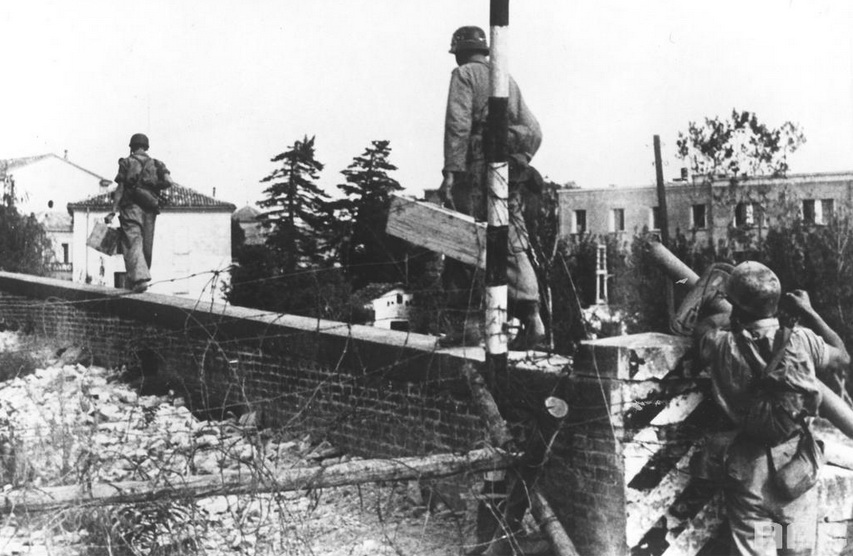 A Fallschirmjäger unit advancing in southern Italy. Balancing on the wall might seem like a strange approach way, but when the area is littered with mines..... The Infanterie Karren 8 (IF8) The Merkblatt 77/2 describes the correct manner of transporting the Panzerschreck (or Ofenrohr, which was the correct designation at the time of printing). A Panzer Zerstörer Gruppe (Anti-tank team) consisted of one group leader, one horse handler and 2 squads of 6 men (including the squad leader). The horse was connected to two standard IF8's. One of them was fitted with a wooden frame that would take 6 Panzerschrecks. This frame ensured that the holding bay of the actual trailer could be used for the ammunition. Judging from a contemporary picture there was enough space for 12 boxes of rockets. The shields would be taken off the launcher and placed on the trailer. The second trailer would be used for even more ammunition and the packs for the soldiers.  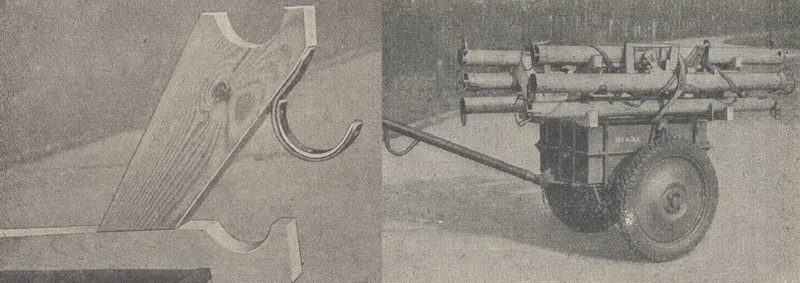 The IF8 with the Panzerschreck frames installed as it was pictured in the Merkblatt 77/2 and the Dias series The IF8 could also be used as a hand-cart by exchanging the horse with a T-bar, but a lighter weight would be needed in order to pull it. 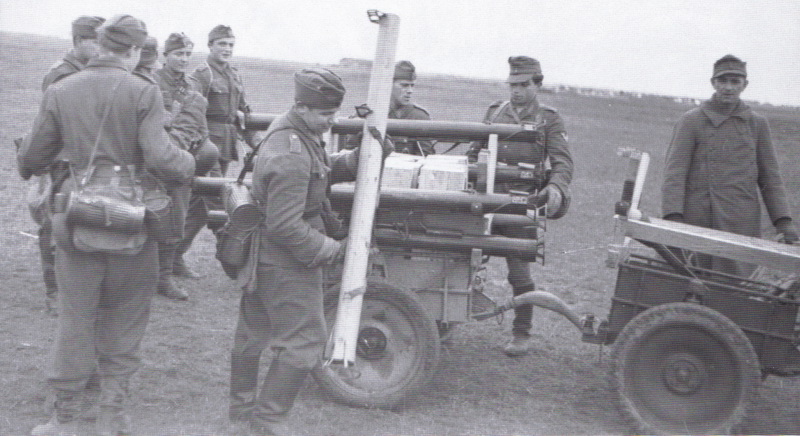   This is a series of pictures taken by Kriegsberichter Gerhard Gronefeld in the spring of 1944 in south Ukraine that shows the unloading of 6 Panzerschrecks from an IF-8 infantry cart. For some strange reason both trailers are fitted with the wooden frames, but only the last one contains the 6 weapons and ammunition. Note the horse handler in the greatcoat and the group leader, armed with a MP40 and a Panzerfaust. Universal carrier A anti-tank unit in Italy was motorized with captured Universal (Bren Gun) carriers. The vehicles must have been captured in large numbers, as these vehicles were also employed as "Ladungsträger" (carrier of a demolition charge) with Funklenk Panzer units. 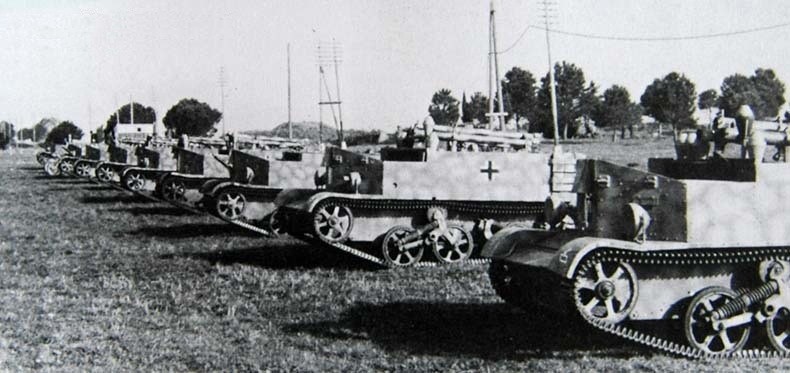 These carriers have been lightly modified with a central gun rack that would take 3 Panzerschrecks and two rear stowage bins that would hold 12 boxes of R. munition 4322. A rack holding 4 Panzerfausts has also been installed. In addition a new coat of paint with camouflage added, and the German Balken-kreuz and tactical insignia as a finishing touch.  A Panzer officer that has been awarded the Ritterkreuz takes a suspicious look inside the main compartment. Picture by Kriegsberichter Vack in Italy (early) 1944. 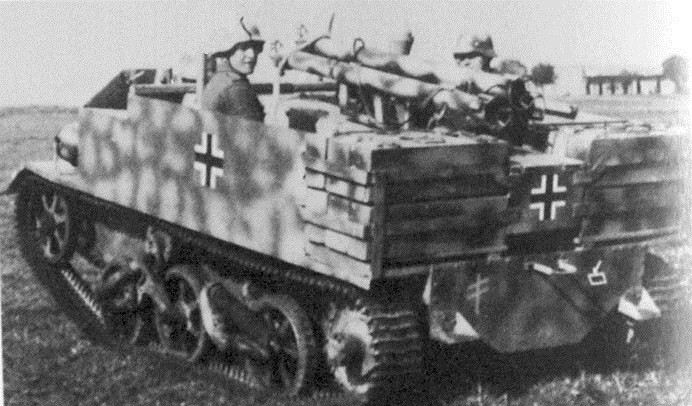 The unit insignia belongs to the 3rd Panzergrenadier Division. This unit was transferred from Italy to the Western front in the summer of 1944 to help re-establish the front line after the Allied breakout from Normandy. The Donkey Express A good soldier will always search for ways to ease his burden, and when danger is not imminent, alternative ways to move his weapon is always welcome. Handcarts, trolleys, strollers or donkeys..... 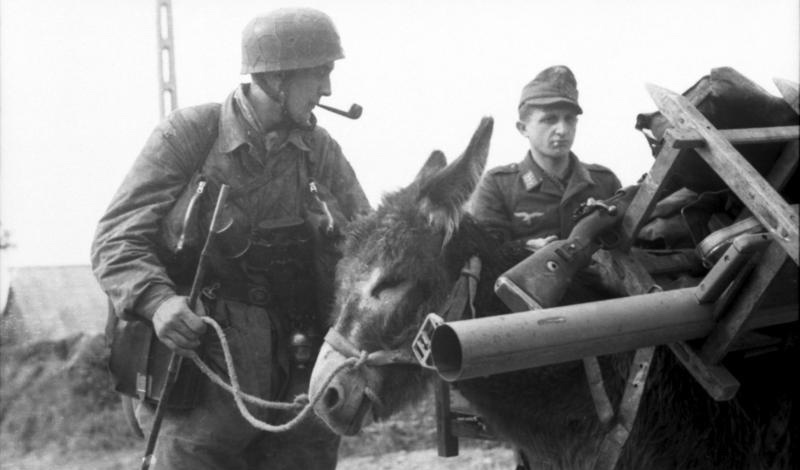 Fallschirmjäger in the area of Saint-Lô, France. Picture was taken in July 1944 by Kriegsberichter Zimmermann. Borgward IV B "Wanze" In the last few months of the war desperate measures were taken in order to halt the attackers of the Reich. A stop-gap measure was the creation of motorized anti-tank units by combining the Panzerschreck that had already proven its value in combat and the Borgward IV B Ladungsträger. It was strictly not a way of "transportation" as such; it was a new weapon system. The Ladungsträger was an offensive weapon that could deliver an explosive charge and then back away before it was detonated. As the days of offensive operations were definitively over in 1945, approx. 56 of these were rebuilt to "Panzerjäger Wanze". It incorporated 6 standard Panzerschrecks that had been simplified in an adjustable mount. All 6 would be fired at the same time, from a concealed position. There was also a wheeled version based on the Kübelwagen, but no pictures exist of this version. 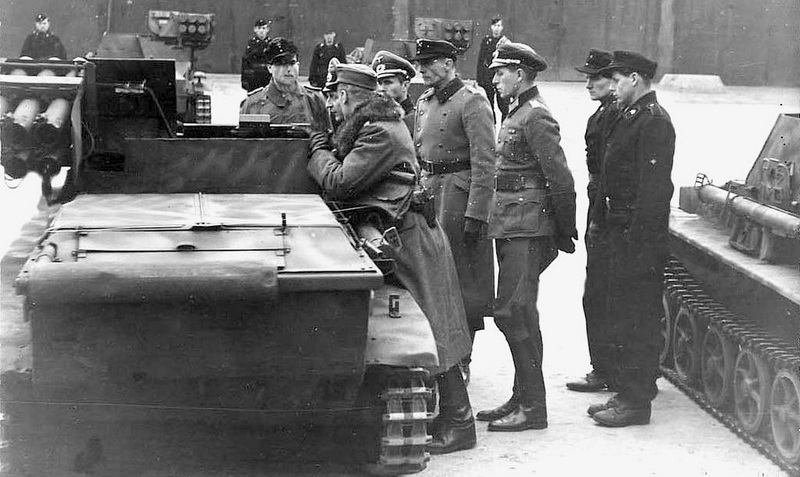 The Panerjäger Wanze on parade. Note the two man crews in the background ready for inspection. The muzzle end has been sealed off with protective covers. Note the standard Panzerschreck in the holder with its shield taken off on the vehicle to the right, and again under the belly of the person closest to the camera. 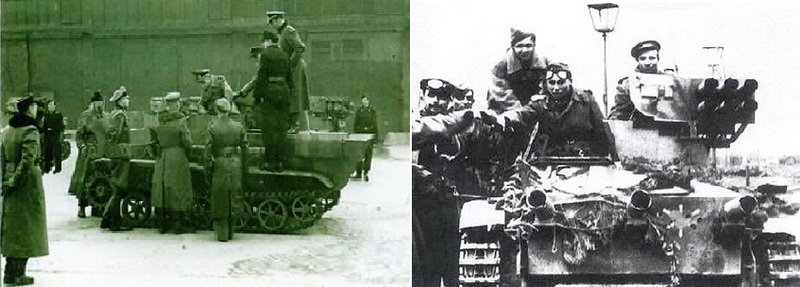 Another shot from the same event. The picture above right is the most famous (and most often encountered) of the Wanze. This vehicle was taken intact by the Russians in the battle for Berlin. Note the three tubes for the Nebelkerzen (smoke boxes). 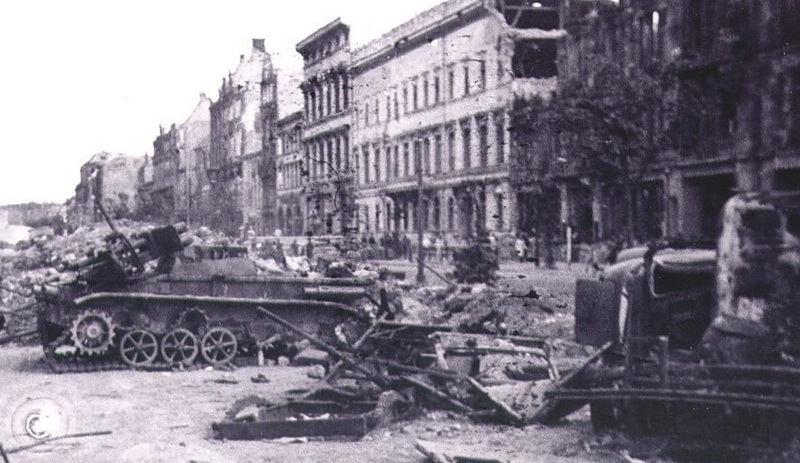 Endkampf Berlin. A shot up/burnt out Wanze lies abandoned among the rubble. Transport of ammunition The Panzerschreck rocket was carried into combat in one out of three described ways, the most common being "in box". As discussed on the ammunition page, the grenade was dangerous to fire if the lead seal on the safety pin was broken or had gone missing. In addition the manual stressed that a grenade with a bent tail-section should only be used for practice and training. The Raket Munitionskasten 4322 was used to transport the grenades into combat to avoid any damage. 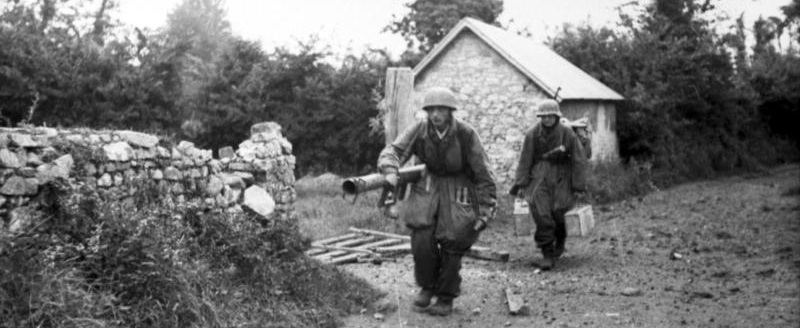 A Fallschirmjäger AT crew advancing in Normandy, summer 1944. Note the missing shield. The loader carries two full boxes, while the gunner has a "loose" rocket in his hand. The R Munitionkasten weighed in at 11 kg full, and 4,4 kg when empty. The excess weight would have been tempting to "ditch".  A wooden frame (Aufsatzgestell) that could be attached to a standard back-pack frame, the Rückentrage 42, was designed and listed as an accessory in the introduction order for the Panzerschreck. Apparently the rack was meant to be manufactured by the units, since the same order states that "drawings will be made". The picture above is from the Dias series.  It was also pictured in both the D 1864/1 and D 1864/6. But there are no contemporary pictures available that shows it in use, so it can't have been manufactured in numbers. 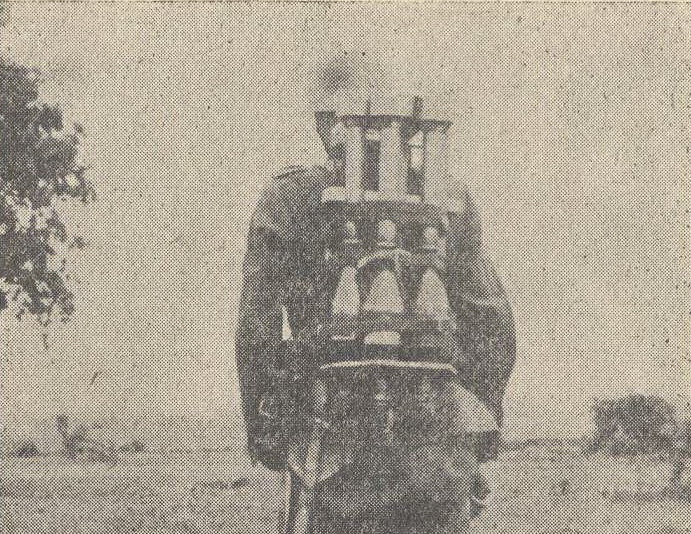 This picture was printed in the Merkblatt 77/2 and shows a prototype of the Aufsatzgestell which apparently had no protective cover for the fuzes, as the text emphasizes that the pack board must be put down very gently so that nothing touches the fuzes. 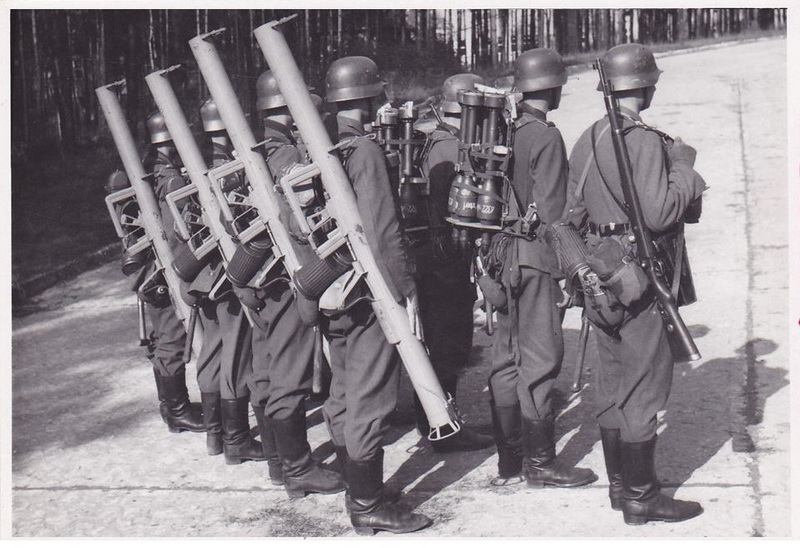 This is the rear view of the same unit that was pictured at the start of this article. They have clearly got the prototype of the Aufsatzgestell, mounted on a standard Tragestell 43 carrying frame. Compared with the photo from the manual Merkblatt 77/2 this must be the same contraption. The picture also clearly shows the GGG98 on the unit leaders right hip. 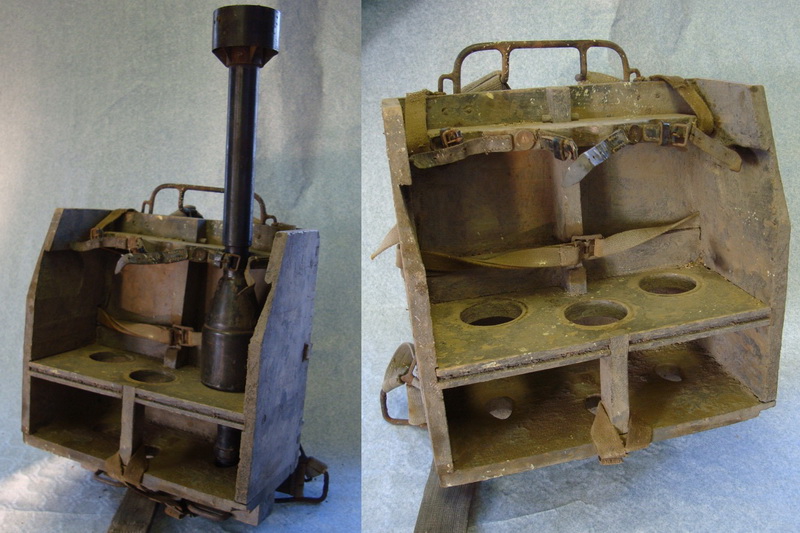 This Aufsatzgestell was sold on Ebay recently, and is the only specimen I have managed to find any picture of, apart from the ones pictured in the manuals. Obviously unit-made and for only three grenades. Note the use of straps instead of metal clips to hold the grenades These two stills were taken from the Deutsche Wochenschau distributed on 7 December 1944. The film shows a sequence of smiling and marching soldiers passing the camera on their way to the front. The soldier in the photo carries a unit-made Aufsatzgestell designed for three rockets. It appears to have been made as a rucksack, and is not attached to a Tragestell. The rockets are held in place by the upper, hinged wooden halfmoon. This is in turn held together by a standard door latch. Thanks to Aleksei from Russia that provided the pictures! The last method was the carrying of loose grenades, a practice that was regulated in the Merkblatt 77/2; Be extremely cautious when transporting loose grenades. Safety pin must not get lost; detonation hazard! The tail of the grenade must not be damaged or bent. The D 1864/6 simply stated "Be careful when transporting loose grenades". 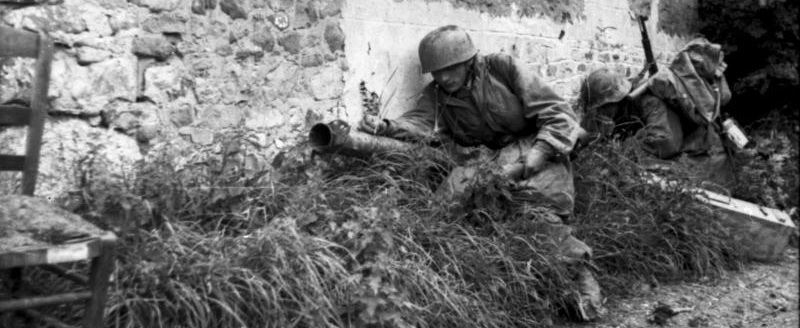 The same pair of Fallschirmjägers from a previous picture, taking cover in the road side by a French house. Note the grenade in the left hand of the gunner. 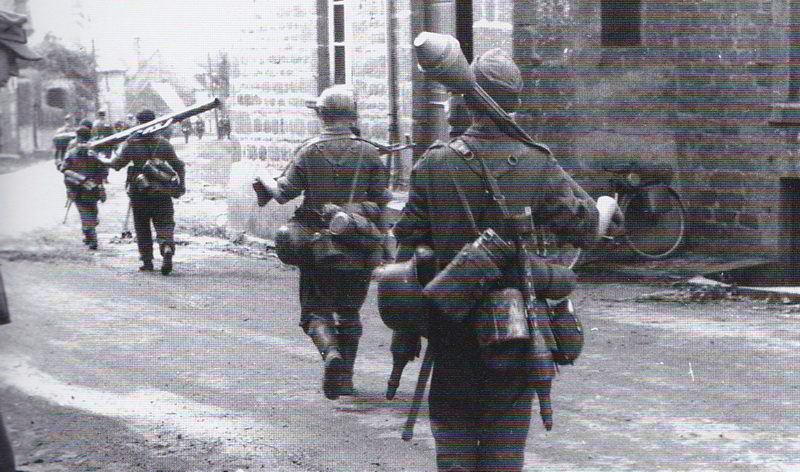 Another photo of the same scene shown above. Grenadiers from the Grenadier-Regiment 1052 passing through the city of Ger in Normandy, August 1944. The man in the middle has slung a MP43 around his neck. The Grenadier closest to the camera carries a Panzerfaust 30 Groß. Note that the he has nonchalantly slung a pair of 4322 grenades across his shoulder, connected by a web strap. In my opinion not according to regulations. The most interesting detail about this picture is the improved igniter visible on the rocket on his back. Up until now this model has only been found with the Arkt 44/45 grenades. This photo strongly suggests that this improvement must have been launched many months earlier! 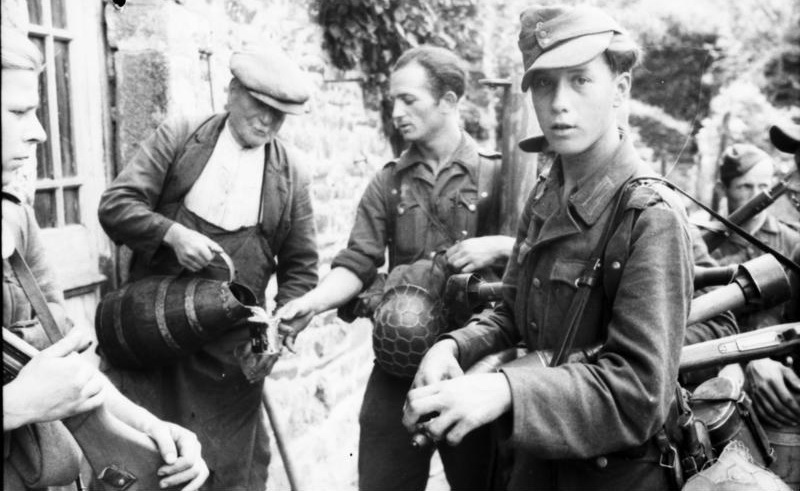 The same Grenadiers take a pause to drink some milk. The MP43 is visible to the left and the Panzerschreck is in the upright position, held by the Grenadier that receives the milk. There are three 4322 grenades visible in the picture. One under each arm held by the Grenadier closest to the camera, and another held by a Grenadier right behind him, almost totally obscured. The grenade carrying Grenadier appears to be toying with the fuzes. His K98k is a late war production with a stamped floor plate. 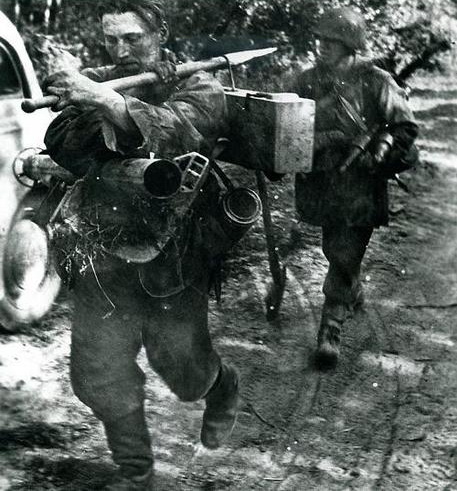 A weary Panzerschreck team on the move. The gunner carries a shovel and a standard ammunition box, while the loader nonchalantly carries two grenades under his left arm and carrying another shovel in his right. |
| Home | For sale | Site map | Contact information | Guest book | The Panzerschreck Lounge |